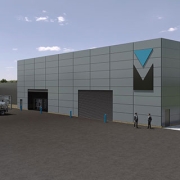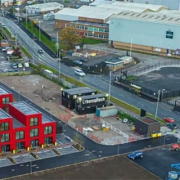The signing in late October of a framework agreement between Tokamak Energy, the Oxford-based global commercial fusion company and the UK Atomic Energy Authority (UKAEA) to develop commercial fusion energy has the potential be groundbreaking. The five-year agreement will take the form of joint technology solutions as well as shared utilisation of equipment and facilities.
The ‘tokamak’ device, after which Tokamak Energy is named, is based on Russian technology dating back to the 1950s, and uses a powerful magnetic field to confine plasma in the shape of a torus.
So after years of uncertainty, the UK Government is now desperate to move the dial forward on nuclear energy, an industry in which it was once a world leader. It is backing nuclear fusion technology through $244m (£220m) in first phase funding for its STEP (Spherical Tokamak for Energy Production) initiative.
In October, the UK picked the Midlands as the site to host its STEP fusion demonstration plant, a $23.9bn fusion power station at the West Burton power station, currently the site of a coal-fired power plant in Nottinghamshire. The question remains, then, as to whether this project can revitalise nuclear power in the UK.
Rebuilding an industry
Nuclear fusion, rather than nuclear fission, is seen as the key to revamping the UK’s moribund nuclear power industry, and the differences between the two nuclear technologies are profound.
Nuclear fission creates power by splitting atoms of radioactive elements like uranium with neutrons releasing an enormous amount of energy. Nuclear reactors use this energy to create steam, which in turn powers a turbine to produce electricity. But while nuclear fission may be less damaging to the environment than fossil fuels, pollution in the form of radioactive waste is a major drawback.
By contrast, nuclear fusion happens when light atoms are smashed together to create heavier atoms creating a huge burst of energy. The hydrogen isotopes most used in fusion are deuterium and tritium. Deuterium is widely available as it can be found in seawater, while tritium can be extracted from lithium.
The interaction between the two is similar to the process that powers the stars in the universe. Melanie Windridge, a plasma physicist who runs the consultancy Fusion Energy Insights told the Financial Times that roughly 1kg of fusion fuel has, “the potential to produce as much energy as ten million kilogrammes of fossil fuels.”
Chris Kelsall, CEO of Tokamak Energy, adds: “We are in a race against time to phase out the world’s reliance on fossil fuels and aim to deliver fusion as a clean, sustainable, low cost and globally available energy source. With over twenty fusion start-ups globally and increasing collaboration between the private and public sectors, investors are awakening to this opportunity.”
In the 12 months to the end of June, the Fusion Industry Association estimates that private fusion companies raised $2.83bn in investment, mainly in the US but also in the UK. Its most recent report states that 93% of companies surveyed in 2022 believe that fusion electricity will be on the grid in the 2030s. This is up from 83% a year previously.
The US is also well on the way towards developing a commercial nuclear fusion facility. Indeed, an executive at the Japanese start-up Kyoto Fusioneering told The Telegraph newspaper that both the US and UK are locked into a two-horse race to crack nuclear fusion and either of them could yet be the first to develop commercial reactors.
Private competition
However, it is the activity in the private sector in both the US and the UK that has provoked the most excitement. The Financial Times reported that a series of scientific breakthroughs and a rush of private investment are raising hopes that it could yet play a meaningful role in cutting global emissions before 2050. The need is urgent because, as Kelsall notes, “There’s no point this technology arriving in 2048 because it’s too late.”
Tokamak Energy’s ST80-HTS, the world’s first high field spherical tokamak combined with high temperature superconductor (HTS) magnets, will be the cornerstone of Tokamak’s new nuclear facility. It will be commissioned in 2026 with the aim of being brought online in the 2030s.
In a statement the company said, “This announcement is a critical springboard for achieving commercial fusion and integrating fusion into future energy systems.” It follows the news in March that Tokamak had achieved, “a plasma temperature of 100 million degrees Celsius” in its ST40 spherical tokamak. This is the threshold required for commercial fusion energy and is, “by far the highest temperature ever achieved in a spherical tokamak,” the company said.
“A pellet generating the energy of a barrel of oil”

Several UK companies are developing commercial fusion reactors, hoping to make the final breakthrough. Credit: Tokamak Energy.
Although both the UKAEA and Tokamak have operational spherical tokamak devices and several government laboratories have also reported plasma temperatures above 100 million degrees in conventional tokamaks, Tokamak Energy’s March milestone was achieved in just five years. Importantly, it was done for a cost of less than $70m, in a much more compact fusion device.
Tokamak said the ST80-HTS, “will demonstrate multiple advanced technologies required for the delivery of commercial fusion energy and will demonstrate the capability to deliver electricity into the grid in the early 2030s, producing up to 200MW of net electrical power.”
Meanwhile, Oxford-based First Light Fusion has been developing another approach called projectile fusion, which involves firing a projectile at a deuterium-tritium fuel pellet to force the isotopes to fuse. Instead of using complex and expensive lasers or magnets to generate or maintain the conditions for fusion, First Light’s approach compresses the fuel inside a target using a projectile travelling at tremendous speed.
The company claims the energy density of the fuel “is so great that a pellet one centimetre wide should be able to generate the same amount of energy as a barrel of oil.” It recently achieved a world fusion first with this approach, and the result has been validated by UKAEA.
The company claims that it “offers a simpler pathway to low-cost fusion energy using existing plant technology,” than the traditional fusion method. Importantly, it has also managed to achieve fusion at a cost of less than $53.8m. “With this simpler approach that reuses existing technology projectile fusion offers a pathway to a very competitive levelised cost of energy of under $50/MWh, directly competing on cost with renewables. This would make it the most cost competitive source of baseload power,” the company says.
The next step, according to Nick Hawker, co-founder and CEO of First Light Fusion, is to partner with existing power producers to develop a pilot plant using its unique fusion approach. It is working towards a pilot plant producing around 150MW of electricity and costing less than $1bn in the 2030s.
Environmental impacts
One of the added benefits of fusion is that unlike fission, nuclear fusion is self-sustaining without creating harmful waste. For that reason, the UK Government in June confirmed that future fusion facilities will be regulated by the Environment Agency and the Health and Safety Executive, rather than the Office for Nuclear Regulation, in a boon for the British fusion industry.
Tokamak’s state-of-the-art project is groundbreaking and Ian Chapman, CEO of the UKAEA, predicts it could be a “really big part” of the UK’s plan to tackle climate change. However he also warned that because it had, “never been done before there is no guarantee that this will work. We’ve never done it at the scale where it produces electricity and actually powers your home.”
With global power demand expected to double by 2040 and increase fivefold by 2060, the need for nuclear fusion is paramount. First Light commissioned research concluded that 19,900TWh per year could be generated from wind and solar globally by 2040.
But although this is a welcome eight-fold increase on today it is still less than half of the projected requirement. “In several parts of the world wind and solar power alone will not be able to meet projected energy demand,” said First Light.
To mitigate the impact of climate change a large global market for baseload clean power will need to open up. This market will complement renewables and that is where fusion energy will play a key role.
Source: Power Technology






 Arthur and Doreen initially left Liverpool and moved to Lancaster but say there were drawn back to the city region because of its history and connectivity.
Arthur and Doreen initially left Liverpool and moved to Lancaster but say there were drawn back to the city region because of its history and connectivity.





